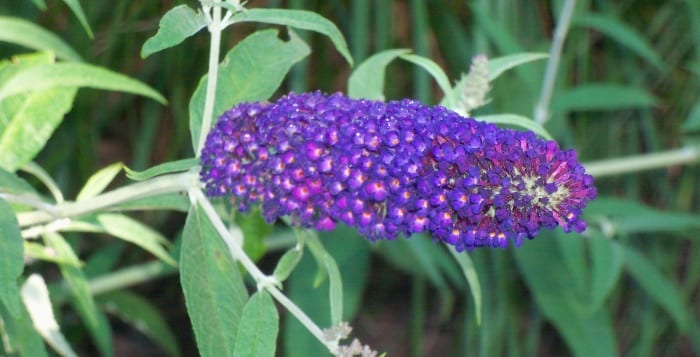By Ellen Barcel
Butterfly bush vs. butterfly weed — what’s the difference? Is one better than the other? Is one invasive? How exactly do these plants support butterflies? These are all interesting questions.
As you plan your garden for next year, you may want to consider plants that attract butterflies. When you see names like butterfly bush and butterfly weed, they seem like the logical choices. But, that’s not necessarily the case. Besides, there are many other plants that also attract butterflies. By the way, butterflies do not eat; they only drink fluids. That means they drink water and the nectar of flowers. It’s the larvae that eat the leaves.
Let’s start with the butterfly bush —Buddleja davidii (also spelled Buddleia). This is a woody deciduous shrub with lilac-colored flowers, but there are some cultivars with dark purple, white and pink flowers. And, yes, there’s even a yellow cultivar — B. davidii ‘Honeycomb.’ The butterfly bush blooms in late July and August with flowers that resemble lilac flowers, which is why it is sometimes called the summer lilac.
Interestingly, there are now reblooming true lilacs that produce flowers not only in spring but in August as well, so you will see both blooming in mid to late summer. A native of Asia, the butterfly bush is viewed by some as invasive in this area, but it is not on Suffolk County’s Do Not Sell List. It can grow to five feet tall and spread easily as wide, but there are dwarf varieties. It does best, producing the most flowers, in full sun.
The nectar of the flowers is a source of nutrition for butterflies, hence its name. Removing the dead flowers helps to encourage the development of more flowers and more butterflies. The plant is hardy in U.S. Dept. of Agriculture hardiness zones 5 to 9.
Now on to the butterfly weed (Asclepias tuberosa). This is a herbaceous perennial with bright orange flowers, although cultivars include ‘Ice Ballet,’ which has white flowers, and ‘Cinderella,’ which is a rose color.
A species of milkweed, the butterfly weed is a native of eastern North America. It blooms from summer to early fall. Yes, it attracts butterflies who drink its nectar, but more than that, butterfly weed also serves as food for the larvae of the monarch butterfly. Because it supports both stages of the butterfly’s life, it really helps the environment, especially at a time when the monarch butterfly numbers have been dwindling, due in part to a smaller natural environment. It requires full sun and prefers a dry, sandy soil. So it will easily grow in Long Island’s soil.
If you see butterfly weed growing wild, don’t cut the flowers. Let them go to seed so that they can reseed and propagate this native plant.
There are many other plants that will attract butterflies to the garden including asters, coneflowers, lilac, mint, pansies, sage, phlox, lupine, lavender, day lily and hollyhock. The ones, like the butterfly weed, that support more than one stage in the butterfly’s life cycle, really help.
There are two butterfly exhibits in Suffolk County. The Sweetbriar Nature Preserve in Smithtown has a butterfly exhibit in the warm weather. Call 631-979-6344 for further information. Atlantis Marine World in Riverhead has a year-round indoor exhibit. Call 631-208-9200. Heritage Park in Mount Sinai has a butterfly garden. Call 631-509-0882 for more information.
Ellen Barcel is a freelance writer and master gardener. Send your gardening questions and/or comments to [email protected]. To reach Cornell Cooperative Extension and its Master Gardener program, call 631-727-7850.





